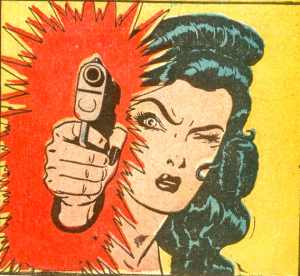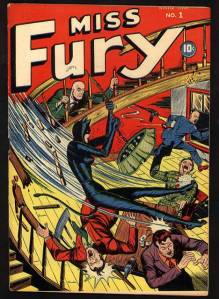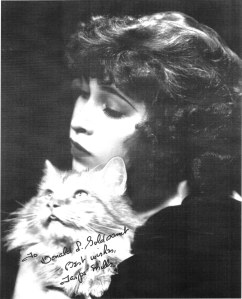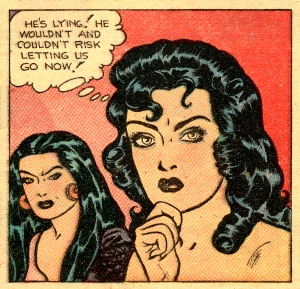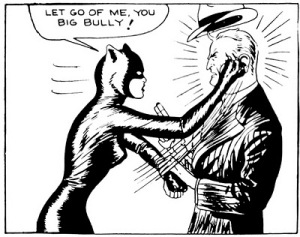It’s my pleasure to welcome Andrez Bergen back to the blog. September sees the release of Andrez’s next novel, Who Is Killing the Great Capes of Heropa, a typically inventive and playful take on the golden age of American comics, as seen through a noir lense. If you’ve read any of his previous work you’ll know what a magpie eye Andrez has, with influences ranging from Soviet propaganda to Dashiell Hammett to Charles Dickens; today he’s sharing one of the points of inspiration for his latest…
THE BLACK FURY: A WOMAN IN TIGHTS; NO CAPE
One of the more meaningful characters in my next novel Who is Killing the Great Capes of Heropa? (to be published in September) is actually an inanimate one.
We’re talking up a doll—which probably augers poorly for the book in question and isn’t the best advertisement for what I’m supposed to be hawking here.
Disclaimers aside, this doll is the childhood plaything of central character Louise Starkwell, a bank clerk at the Warbucks & Erewhon Union Trust Bank, and it has a name: Tarpé Mills.
A reason for the meaningful nature of this pre-plastic thing made from glue mixed with sawdust is in nicking its moniker from another Tarpé Mills—the flesh-and-blood woman, real name June Mills, who created comic book daredevil Miss Fury way back in April 1941.
Initially called Black Fury (a title promptly changed), Miss Fury always was the kind of label that’d snag the noir/femme fatale-inclined side of me, yet until last year I’d never heard of the character.
This being a confession (of sorts) brings me full circle to the point where, having discovered her, I’m now paying the respect you’ll discover here.
In a book heavily influenced by the lads’ locker room that was New York’s Marvel (Comics) Bullpen in the 1960s, as well as the California-baked hardboiled fiction of Dashiell Hammett and Raymond Chandler (also men’s men) from the 1930s on, when I started doing research into the basic premise for this story I figured it essential to shoehorn in the leverage of a woman of some repute, if only to get a much-needed sense of balance.
After all, I’d grown up with tough, self-reliant women including my mother, Sigourney Weaver in Alien, Mary Astor in The Maltese Falcon, British TV show The Avengers’ Emma Peel, Buffy, Xena, even Lady Penelope Creighton-Ward in Thunderbirds. The “fair-sex” fragility inherent in a lot of American comic books leading up to the 1970s was something preferable to ignore.
Yet I wasn’t expecting to discover what I subsequently did.
Turns out, Miss Fury was the first female action hero created by a woman, beating Wonder Woman into print by over six months.
Her often risqué newspaper strips ended up being published over the next decade, with Timely (Marvel’s predecessor during the so-called Golden Age of Comics) reprinting the strips in comic book form from 1942-46.
Tarpé Mills, the creative force behind the series, had previously pursued a calling in fashion design and also developed comic book characters Devil’s Dust, the Cat Man, the Purple Zombie and Daredevil Barry Finn—but it’s Miss Fury who’s the outstanding creation.
Though far less travelled, Mills used herself as the model for globe-trotting adventurer and wealthy socialite Marla Drake—a woman without particular powers who dons a black leopard skin catsuit (sans cape) to confront “Nazi threats, romantic entanglements, catfights, curses, and gangsters”.
Drake’s character may seem a tad Catwoman-esque in light of that skin-tight black costume, but Miss Fury actually predates DC comics’ femme fatale in terms of fashion.
When Selina Kyle became “the Cat” opposite Batman in 1940, her first swing at a costume was a furry, purple cat mask with an outfit straight out of a Buck Rogers movie-house romp. It wasn’t till ‘47 that Selina seriously called herself “Catwoman” and threw on more appropriate livery (the infamous purple dress and green cape). Still later, Catwoman’s apparel bore more than a passing resemblance to Fury‘s, right down to the figure-hugging catsuit, pointy ears and claws.
It’s also fairly obvious that the Second World War offered a creative field day for Marla Drake and her author Mills.
Chief among the imported problems (courtesy of the always dastardly Third Reich) was Baroness Erica von Kampf, a platinum-blonde counterpoint to our brunette heroine, who fills out the role of Miss Fury’s major nemesis.
Incidentally, von Kampf had her own influence on another character in Who is Killing the Great Capes of Heropa?—the throwaway ‘Nazi’ villain, Baron von Gatz.
Von Gatz is equal parts Red Skull (as perfected by Jack Kirby and Stan Lee at Marvel in 1968) and the Prince Valiant bewigged bad-boy opera singer Rodolfo Lassparri from Marx Brothers film A Night at the Opera (1935). He got his label courtesy of another, lesser Golden Age comic book character by the same name that fought Captain Midnight over at Fawcett Publications in the ’40s.
Anyway, in my novel the doll Tarpé Mills fulfils a point made about what, precisely, constitutes life; she’s the memory someone shouldn’t have—and in a diabolical scene the toy’s eyes are gouged out in a “see no evil” moment. I’ll admit there is a minor degree of symbolism here, in that the real Tarpé Mills retired from the comic book industry in 1952—right before the publication of Fredric Wertham’s hysterical, anti-comic book tome, Seduction of the Innocent.
Miss Fury would doubtless have been one of the targets of Wertham’s criticisms and the de facto censorship thereafter by the Comics Code Authority.
Let’s put honesty on the sleeve here.
In a book rife with sometimes overly sly comic book references and name-dropping most people will never get anyway (and probably won’t care to try), the Tarpé Mills homage ended up being one of those that meant most to me, and through writing Who is Killing the Great Capes of Heropa?—a novel originally inspired by the exploits of fantastic men wearing snug union suits and cowls—I discovered a character of the opposite sex I now cherish.
The female gender in Marvel comic books in the ’60s indulged in much swooning, the odd faint, and rapture over fashion accessories or handsome men. I’m looking at you, Sue Storm (Invisible Girl), Jean Grey (Marvel Girl) and especially Janet van Dyne (the Wasp).
While Miss Fury had her fair share of these ailments twenty years before—you’ve got to read the yarns in context of the times—she possessed the rough-and-tumble aesthetic down pat beyond her alter ego’s glam lifestyle.
Drake also proved women could stand up to the best of the crooks,man or woman, when most of her female peers—even two decades later—were beholden to rescue by the men-in-tights running their four-colour show.
Heck, Miss Fury’s escapades earned her the honour of being painted across the fuselage of three or four World War II era B-29 bombers.
Take that, Miss Jupiter.
– Andrez Bergen
